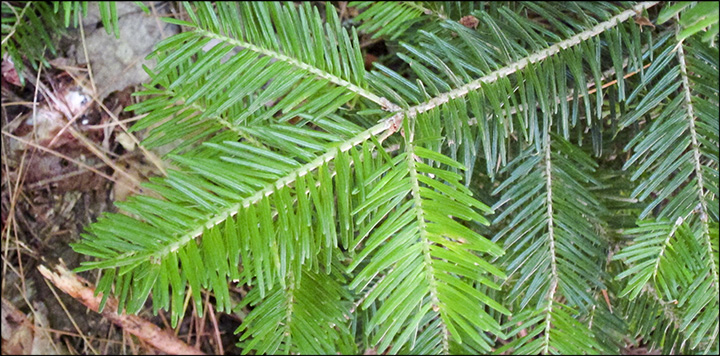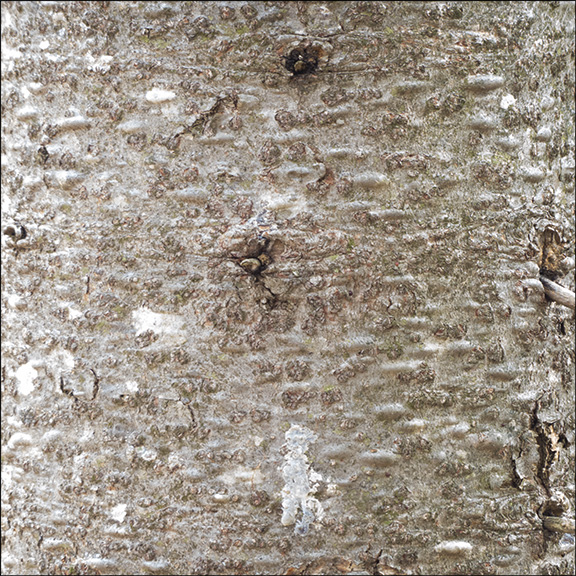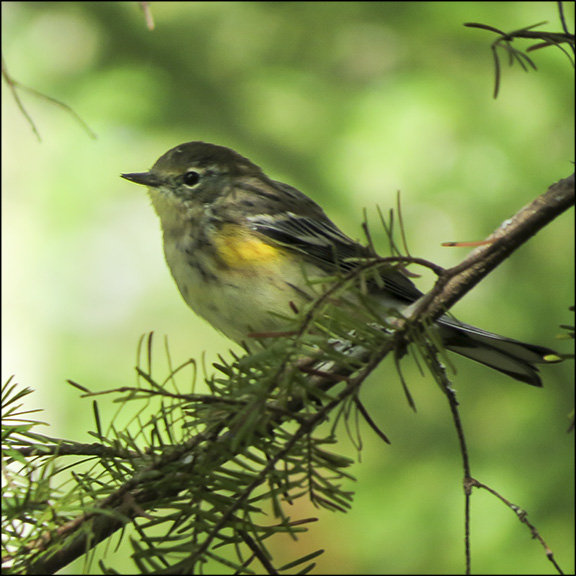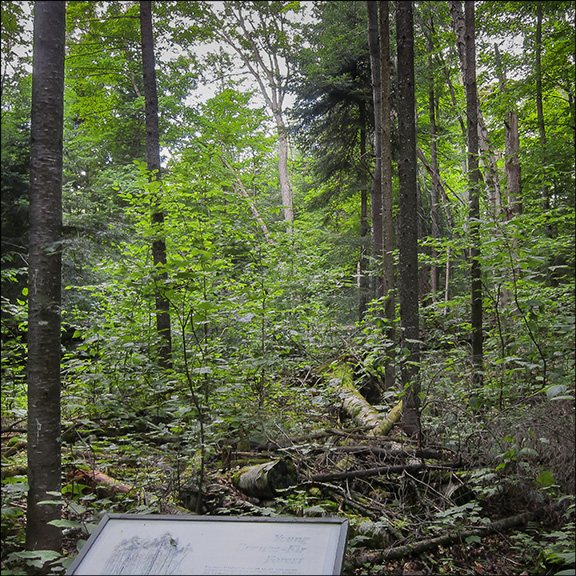Trees of the Adirondacks:
Balsam Fir (Abies balsamea)
 Trees of the Adirondacks: Balsam Fir needles are short, flat, and friendly to the touch. Balsam Fir on the Barnum Brook Trail (21 July 2012)
Trees of the Adirondacks: Balsam Fir needles are short, flat, and friendly to the touch. Balsam Fir on the Barnum Brook Trail (21 July 2012)
| This page is no longer being updated. For an updated and expanded version of this material, see: Balsam Fir (Abies balsamea). |
The Balsam Fir (Abies balsamea) is a small to medium-sized tree widespread in moist woodlands and swamps in boreal forests of the Adirondacks. Within its range it may also be referred to as Balsam, Canadian Balsam, Canada Balsam, Eastern Fir, and Bracted Balsam Fir. It is the provincial tree of New Brunswick. This species is a member of the pine family.

Identification of the Balsam Fir: The Balsam Fir features aromatic foliage and a narrow, pointed, spire-like crown. The needles are flat, about 3/4 long, and dark green in color. The under side of the needle is pale with a few white lines. Like all firs, the needles are generally the longest in the middle of the twig. The needles are arranged spirally on the shoot. However, on the lower branches, the leaf bases are twisted to appear in two more-or-less horizontal rows. On branches higher on the tree or those exposed to direct sunlight, the needles project in all directions like spruce needles. Chemicals in the needles give this tree a unique defense against insect feeders, as they mimic a growth hormone that interferes with normal insect metamorphosis.
Balsam Fir bark is thin, gray and smooth, with many resin blisters. The bark often becomes broken into irregular brownish scales as the tree ages. Both male and female cones occur on the top branches of the tree. The cones are 1.5 to 3 inches long. The cones are purplish in color and stand erect on branches. The twigs are smooth.
Keys to identifying the Balsam Fir and differentiating it from other coniferous trees include its needles, bark, and habitat.
- Balsam Fir trees are easily distinguished from Eastern White Pine, since the latter tree has much longer needles in bundles, while the needles of the Balsam Fir grow individually on the twig.
- Balsam Fir needles can also be differentiated from those of the Red Spruce, which are sharp-pointed and prickly, growing all around the twig. Balsam Fir needles, particularly those on lower branches, appear to be two-ranked. The needles appear to occupy a single horizontal plane and are soft and friendly to the touch. Moreover, Red Spruce needles are four sided, in contrast to the flat needles of the Balsam Fir. Finally, the cones of Red Spruce are orange-brown, contrasting with the bluish brown cones of the Balsam fir.
- The arrangement of Balsam Fir needles also contrasts with that of Tamaracks. Tamarack needles are relatively short, like those of the Balsam Fir, but are produced in clusters of ten to twenty, as opposed to the single needles of the Balsam Fir. Moreover, Tamaracks thrive in much wetter soil than Balsam Fir.
- Balsam Fir is also easy to distinguish from Black Spruce, since the latter species thrives in bogs, where Balsam Fir does not grow.
Differentiating Balsam Fir from Eastern Hemlock is somewhat trickier.
- Balsam Fir needles, like those of the Eastern Hemlock, are flat and white-lined below. In both cases, the needles appear to occupy a single horizontal plane. However, the needles of the Eastern Hemlock are attached to the twig by tiny slender stalks, in contrast to those of the Balsam Fir, which are not stalked.
- The cones of these two species are very different. Those of the Eastern Hemlock are much smaller and pendant, while those of the Balsam Fir are upright.
- The growth habits of the two species are different. The Balsam Fir is conical, with ascending branches, while the Eastern Hemlock has a loose, feathery silhouette. The topmost shoot of hemlocks tend to droop, in contrast to the conical shape of firs and spruces.
- Balsam bark is another key identifier, since it features many resin blisters which emit a spicy-scented resin.
Uses of the Balsam Fir: This tree is used primarily for pulp and light frame construction. It has been used for paneling, crates, barrels, and plywood, and other products not requiring high structural strength. The tree's main economic value is as Christmas trees, since balsam holds its aromatic needles indoors much longer than spruce. The aromatic foliage of Balsam Fir is also used to make balsam pillows. The resin has been used for medicine, turpentine, glue, and varnish. The resin was formerly used in medicine, optics, and microscopy, but has now largely been replaced by synthetics.
This plant was widely used medicinally by various North American Indian tribes. Native American tribes made extensive use of Balsam Fir to treat a wide variety of ailments, including heart disease, colds, kidney pains, sore throat, rheumatic joints, headache, coughs, boils, bruises, sprains, and colic. Several tribes used the needles to make pillows, believing that the aroma promoted good health.

Wildlife Value of the Balsam Fir: The Balsam Fir is moderately important to wildlife. The evergreen foliage of young trees is useful to mammals and game birds for cover, especially in winter. Browsers, particularly White-tailed Deer and Moose, may resort to fir foliage as a large part of their winter menu. The seeds are sought by Red Squirrels, chipmunks and other rodents. Porcupines feed on the bark.
Balsam Fir provides food and breeding habitat for a number of birds. The winged seeds are eaten from the cones by at least eight species of songbirds (such as crossbills). Yellow-bellied Sapsuckers chisel feeding wells in the bark. Yellow-rumped Warblers, Magnolia Warblers, Veery, and Rose-breasted Grosbeaks often choose this species as a nest site.
The Balsam Fir is a common tree species in the breeding habitat of a wide variety of birds, including:
Distribution of the Balsam Fir: This species is widely distributed in northeastern North America. In Canada, the tree's range extends from Newfoundland and Labrador west through the more northerly portions of Quebec and Ontario. In the United States, the range of the Balsam Fir extends from extreme northern Minnesota west of Lake-of-the-Woods southeast to Iowa; east to central Wisconsin and central Michigan into New York and central Pennsylvania; then northeastward from Connecticut to the other New England States. In New York State, the Balsam Fir is found in most of the northeastern counties, encompassing the Adirondack Park, as well as the Catskills.
This tree grows best in the eastern part of its range in southeastern Canada and the Northeastern United States, in areas characterized by cool temperatures and abundant moisture. Balsams are usually found in mixed conifer forests with Eastern Hemlock and spruce. It also grows in mixed hardwood/conifer forests with aspens, birches, maples and beech species.

Balsam Fir at the Paul Smiths VIC: Balsam Fir trees, in contrast to Black Spruce and Tamaracks, do not grow in the middle of bogs or marshes. However, they do like moist areas, so look for them in somewhat swampy areas or near the banks of brooks. They can usually be found in mixed stands, with other conifers and hardwoods that are tolerant of moist soils.
Look for Balsam Fir along many of the trails at the VIC, growing near Hobblebush, Eastern Hemlock, Red Maple, and Red Spruce. A number of herbaceous plants flourish near this tree, including Twinflower, Creeping Snowberry, Common Woodsorrel, Bunchberry, Canada Mayflower, Clintonia, and Painted Trillium.
The most convenient place to observe the Balsam Fir and compare it with other conifers at the VIC is on the Barnum Brook Trail. This species is one of the eleven tree species marked with signage along this trail. The identified Balsam Fir is about a third of a mile from the entrance gazebo. If you take the left hand fork and walk the trail in a clockwise direction, the tree is just past the first overlook, on the left hand side of the trail.
References
- United States Department of Agriculture. Forest Service. Silvics of North America. Balsam Fir. Retrieved 8 March 2015.
- United States Department of Agriculture. Balsam Fir Plant Guide. Retrieved 8 March 2015.
- Lady Bird Johnson Wildflower Center. Native Plant Database. Retrieved 8 March 2015.
- University of Wisconsin. Trees of Wisconsin. Abies balsamea. Retrieved 8 March 2015.
- Online Encyclopedia of Life. Abies balsamea. Retrieved 8 March 2015.
- University of Wisconsin. Robert W. Freckmann Herbarium. Retrieved 8 March 2015.
- New York Flora Association. New York Flora Atlas. Retrieved 8 March 2015.
- University of Michigan. Native American Ethnobotany. A Database of Foods, Drugs, Dyes and Fibers of Native American Peoples, Derived from Plants. Retrieved 8 March 2015.
- Plants for a Future. Database. Retrieved 8 March 2015.
- The Birds of North America. Subscription Web Site. Black-backed Woodpecker, Boreal Owl, Downy Woodpecker, Yellow-rumped Warbler, Veery, Cape May Warbler, Evening Grosbeak, Boreal Chickadee, Mourning Warbler, Bay-breasted Warbler, Nashville Warbler, Blackpoll Warbler, Golden-crowned Kinglet, Brown Creeper, White-throated Sparrow, Bicknell's Thrush, and Rose-breasted Grosbeak. Retrieved 8 March 2015.
- Trees of the Northern Forest Trail Walk
- New York State Department of Environmental Conservation. Winter Deer Foods. Retrieved 8 March 2015.
- Paul Smith’s College VIC. Barnum Brook Tree Game.
- George A. Petrides. A Field Guide to Eastern Trees (Boston: Houghton Mifflin Company, 1998), pp. 40-41, 176.
- George A. Petrides. A Field Guide to Trees and Shrubs (Boston: Houghton Mifflin Company, 1958,1972), pp. 4, 20-21, 38-39.
- Gil Nelson, Christopher J. Earle, and Richard Spellenberg. Trees of Eastern North America (Princeton : Princeton University Press), pp. 52-53.
- C. Frank Brockman. Trees of North America (New York: St. Martin's Press), pp. 46-47.
- Keith Rushforth and Charles Hollis. Field Guide to the Trees of North America (Washington, D.C., National Geographic, 2006), p. 57.
- National Audubon Society. Field Guide to North American Trees. Eastern Region. (New York: Alfred A. Knopf, 1980), Plates 22, 480, pp. 277-278.
- John Kricher. A Field Guide to Eastern Forests. North America (Boston: Houghton Mifflin, 1998), pp. 62-67, 88-90, 122-123.
- Alexander C. Martin, Herbert S. Zim, and Arnold L. Nelson. A Guide to Wildlife Food Habits (New York: Dover Publications, 1951), pp. 292-293.
- Bruce Kershner, et al. National Wildlife Federation Field Guide to Trees of North America (New York: Sterling Publishing Co., 2008), pp. 108, 111.
- John Eastman. The Book of Forest and Thicket. Trees, Shrubs, and Wildflowers of Eastern North America (Harrisburg, Pennsylvania, 1992), pp. 10-12.
- David Allen Sibley. The Sibley Guide to Trees (New York: Alfred A. Knopf, 2009), pp. 52-53.
- Charles Fergus. Trees of Pennsylvania and the Northeast (Mechanicsburg, Pennsylvania: Stackpole Books, 2002), pp. 2-5.
